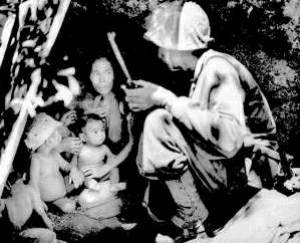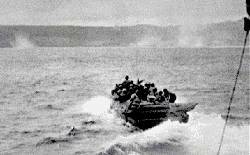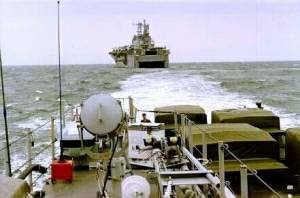

 |
Search the Site with

|
 Plans to launch an offensive against the Japanese in the islands of the Pacific were initiated in 1943 at the Quadrant Conference held in Quebec. President Franklin Roosevelt received the proposal that the Allied effort in the Pacific should be directed first toward the Gilbert Islands, then the Marshalls, followed by Wake, the Eastern Carolines, and finally the Marianas. It was at Saipan that American military planners were presented with the problem of how to cope with a dense civilian population, the first to be encountered in the Pacific war. American forces were to be under the overall command of Admiral Chester Nimitz.
Plans to launch an offensive against the Japanese in the islands of the Pacific were initiated in 1943 at the Quadrant Conference held in Quebec. President Franklin Roosevelt received the proposal that the Allied effort in the Pacific should be directed first toward the Gilbert Islands, then the Marshalls, followed by Wake, the Eastern Carolines, and finally the Marianas. It was at Saipan that American military planners were presented with the problem of how to cope with a dense civilian population, the first to be encountered in the Pacific war. American forces were to be under the overall command of Admiral Chester Nimitz.
The American drive across the Pacific would be two-pronged. While Nimitz fought his way across the central Pacific, General MacArthur would advance across the southwest Pacific to the Philippines. The islands of the central Pacific either succumbed one by one under the sheer weight of American forces or were bombed, neutralized and bypassed. With their supply lines cut, the defenders of by-passed islands were left to starve. After the fall of the Marshall islands, no other island in the central Pacific would be invaded by American ground forces until the American armada reached the waters off the Marianas and the island of Saipan.
American war strategy in the western Pacific was developed around the premise that Japan would never surrender and that the nation would fight to the last man, woman, and child, particularly if the home islands were invaded. It was anticipated that such an invasion, if it were to occur, would result in the loss of one million American lives. In planning for this eventuality, air bases in the Marianas were essential in order to accommodate the new B-29 Superfortress, a U.S. bomber that was just beginning to be mass-produced in early 1944 and which had a flying range equal to the distance from Saipan, Tinian and Guam to Japan and back. The B-29's normal range was 2,850 miles at 358 m.p.h. with a 20,000 ton carrying capacity at 32,000 feet. The capture of the island of Saipan thus became crucial in the preparations for this massive invasion.
The assault on Saipan began on June 15,1944, almost a week after the invasion of Europe. An armada of 535 ships carrying 127,570 U. S. military personnel (two-thirds of whom were Marines of the 2nd and 4th Divisions) converged on the island. The ships of the invasion force carried 40,000 different items to support the assault - everything from toilet paper to government-issue coffins. A single supply ship carried enough food to feed 90,000 troops for one month. Navy tankers transported the gigantic quantity of petroleum products required to support the invasion. Aircraft alone consumed over 8 million gallons of aviation fuel during the battle, while the aircraft carriers burned more than 4 million barrels of fuel.
Seven American battleships and 11 destroyers shelled Saipan and Tinian for 2 days before the landings, firing 15,000 16-inch and 5-inch shells at the islands along with 165,000 other shells of other caliber. To even begin to comprehend the magnitude of this onslaught, one needs to realize that a single 16-inch round weighs slightly more than a Volkswagen Beetle, besides being packed with high explosives. On the second day of the bombardment, this force was joined by 8 more battleships, 6 heavy cruisers and 5 light cruisers. The islands were ringed by American warships with their guns blazing. Shells rained down on the island, its villages, inhabitants, and defenders, gouging huge craters in the sand and coral. The earth trembled under the tremendous explosions of naval bombardment and simultaneous air attacks.
 The main invasion force landed along 4 miles of beach at Chalan Kanoa. Twenty-eight U. S. tanks were destroyed the first day alone. The Japanese positioned colored flags in the lagoon to mark the range of the landing force and to register their howitzers on the invaders from locations behind Mount Fina Susu, and their shell fire rained down on the advancing American force every 15 seconds in a deadly cauldron of exploding steel. By nightfall of the first day, the Second Marine Division had sustained 2,000 casualties. The fighting continued until July 9th, when organized resistance on Saipan ceased. When the fighting ended, American losses on Saipan were double those suffered on Guadalcanal. Of the 71,034 U. S. troops landed on Saipan, 3,100 were killed, 13,100 wounded or missing in action. Out of the 31,629 Japanese on Saipan, approximately 29,500 died as a result of the fighting, and only 2,100 prisoners survived. Fighting between the Japanese and the Americans was by no means completely mechanized; while ships, aircraft, artillery, and tanks inflicted the largest amount of damage to the combatants, a great deal of the fighting was hand-to-hand. Besides machine guns, flame throwers, rifles, and pistols, deadly skirmishes were fought with bayonets, swords, bamboo spears, clubs, stones and fists.
The main invasion force landed along 4 miles of beach at Chalan Kanoa. Twenty-eight U. S. tanks were destroyed the first day alone. The Japanese positioned colored flags in the lagoon to mark the range of the landing force and to register their howitzers on the invaders from locations behind Mount Fina Susu, and their shell fire rained down on the advancing American force every 15 seconds in a deadly cauldron of exploding steel. By nightfall of the first day, the Second Marine Division had sustained 2,000 casualties. The fighting continued until July 9th, when organized resistance on Saipan ceased. When the fighting ended, American losses on Saipan were double those suffered on Guadalcanal. Of the 71,034 U. S. troops landed on Saipan, 3,100 were killed, 13,100 wounded or missing in action. Out of the 31,629 Japanese on Saipan, approximately 29,500 died as a result of the fighting, and only 2,100 prisoners survived. Fighting between the Japanese and the Americans was by no means completely mechanized; while ships, aircraft, artillery, and tanks inflicted the largest amount of damage to the combatants, a great deal of the fighting was hand-to-hand. Besides machine guns, flame throwers, rifles, and pistols, deadly skirmishes were fought with bayonets, swords, bamboo spears, clubs, stones and fists.
The ratio of battle dead was 9.5:1 during the 24 days of fighting. Place names given the rugged Saipan terrain such as Death Valley, Purple Heart Ridge and Harakiri Gulch testified to the bitter fighting. One of the most lamentable events of the battle for Saipan involved the mass suicide of hundreds of families, many of whom jumped to their deaths from the high cliffs at the island's northernmost point. This tragic event could not be stopped, despite efforts by Americans and indigenous Saipanese using loudspeakers to try to convince the Japanese that surrender would be shameless and harmless.
 Saipan provided the United States military with its first opportunity to learn about military occupation of enemy territory with a Japanese civilian population. Civilians encountered during the period of the battle and afterward, while emergency conditions still prevailed, were placed in secure camps to keep them out of the way of the fighting. Thus assembled, the U.S. military could better meet their basic needs for food, clothing, shelter and medical care. Schools were established as soon as conditions permitted. In September, 1945, the camps housed 13,954 Japanese, 1,411 Koreans, 2,966 Chamorros and 1,025 Carolinians. Contained within a two square mile area near Lake Susupe, the compounds were primitive and only the bare necessities were available. Weathered boards, tattered tents and battered tin sheets from the island's bombed-out sugar refinery provided the only shelter from the weather. Each hut (han) accommodated from 20 to 55 people. After the fighting, families were released from Camp Susupe during the day to cultivate vegetables, as food was scarce. Food production was increased from 79,469 pounds of produce in September, 1944 to 286,029 pounds in September, 1945. The camp also had a makeshift Buddhist temple, where Shinto religious ceremonies were held. Release from these camps is celebrated as "Liberation Day" by inhabitants of Saipan to this day on the 4th of July. The Japanese on Saipan had a high birth rate - about 300 babies per 1,000 women aged 15 to 45 - and there were many orphans in the camps who were attended and raised by Japanese nurses. Most of these were the children of Japanese parents who had killed themselves during the mass suicide.
Saipan provided the United States military with its first opportunity to learn about military occupation of enemy territory with a Japanese civilian population. Civilians encountered during the period of the battle and afterward, while emergency conditions still prevailed, were placed in secure camps to keep them out of the way of the fighting. Thus assembled, the U.S. military could better meet their basic needs for food, clothing, shelter and medical care. Schools were established as soon as conditions permitted. In September, 1945, the camps housed 13,954 Japanese, 1,411 Koreans, 2,966 Chamorros and 1,025 Carolinians. Contained within a two square mile area near Lake Susupe, the compounds were primitive and only the bare necessities were available. Weathered boards, tattered tents and battered tin sheets from the island's bombed-out sugar refinery provided the only shelter from the weather. Each hut (han) accommodated from 20 to 55 people. After the fighting, families were released from Camp Susupe during the day to cultivate vegetables, as food was scarce. Food production was increased from 79,469 pounds of produce in September, 1944 to 286,029 pounds in September, 1945. The camp also had a makeshift Buddhist temple, where Shinto religious ceremonies were held. Release from these camps is celebrated as "Liberation Day" by inhabitants of Saipan to this day on the 4th of July. The Japanese on Saipan had a high birth rate - about 300 babies per 1,000 women aged 15 to 45 - and there were many orphans in the camps who were attended and raised by Japanese nurses. Most of these were the children of Japanese parents who had killed themselves during the mass suicide.
After the capture of Saipan, the fighting continued elsewhere in the Pacific for another 13 months. Camps on Tinian were constructed to house 50,000 U.S. troops and 1.2 million pounds of crops were produced, all of which were consumed on the island. On August 6, 1945, an American Superfortress flying from Tinian dropped the first atomic bomb on Hiroshima, hastening Japan's capitulation. The war formally ended with Japan's surrender on August 15, 1945. The final surrender on the island of Saipan did not take place, however, until December 1, 1945, when Japanese Army Captain Sakeo Oba, who had continued to hold out in the mountains with 46 men as a guerrilla force, surrendered his Samurai sword to Major Herman Lewis and Colonel Scott, USMC.
About 90 percent of the civilian population on Saipan survived the war. These included Koreans, Okinawans, and Japanese who were subsequently repatriated to their respective homelands. As recorded on December 31, 1949, the indigenous population of Saipan was 6,225. In 1937 23,658 persons had inhabited Saipan (4,145 were indigenous).
Today, what little World War Two equipment remains after being collected and sold for scrap after the war is protected by law because of its historical value. Lying below the surface of a lagoon once congested with landing craft and ships of all type are the coral encrusted tools of war. Rifles, helmets, bullets, tanks, ships and landing craft litter the sandy lagoon floor as if in an underwater time capsule in silent testimony to one of the last battles fought in a pre-nuclear age. More than fifty years after the invasion, unexploded live ordnance still poses a very real danger to the unwary diver or souvenir hunter.
Four Marines received the Medal of Honor for heroism during the Battle of Saipan. Each lost his life in the action for which he was honored. The four were: Gunnery Sergeant Robert H. McCard, 4th Tank Battalion; Sergeant Grant F. Timmerman, 2nd Tank Battalion; Private First Class Harold G. Agerholm, 4th Battalion, 10th Marines, 2nd Marine Division; Private First Class Harold G. Epperson, 1st Battalion, 6th Marines, 2nd Marine Division. Gunnery Sergeant McCard, a native of Syracuse, NY, single-handedly covered the escape of his crew from a disabled tank. He faced the fire of a battery of anti-tank guns with hand grenades and a machine gun. Sergeant Timmerman, who came to the Marine Corps from Americus, KS, threw himself across an open tank hatch to protect his crew from an enemy grenade. PFC Agerholm disregarded heavy enemy fire and personally evacuated 45 wounded Marines during an enemy attack on an artillery position. Agerholm, a native of Racine, WI, was killed by a sniper as he tried to help two other wounded men. PFC Epperson of Akron, OH, threw himself on a hand grenade, which landed in his machine gun position during an enemy attack. His action saved the rest of his gun crew.
 Back to USS SAIPAN site.
Back to USS SAIPAN site.